Marks & Spencer Case Study: Leadership, Management & Performance
VerifiedAdded on 2023/06/18
|13
|4188
|288
Case Study
AI Summary
This case study provides an in-depth analysis of the managerial and leadership styles employed by the CEO of Marks & Spencer (M&S). It examines the CEO's approach through various managerial models, focusing on transformational, authoritative, strategic, and afflictive styles, and suggests improvements in adopting a more afflictive approach. The study explores the organizational structure changes implemented by the CEO to enhance performance, highlighting the transition to a flatter structure and the establishment of a power culture. Furthermore, it delves into the CEO's leadership style, distinguishing between authoritative and afflictive approaches, and assesses the impact of power, influence, and conflict within the company. Finally, the case study discusses the motivation strategies used at M&S, referencing Marlow's need hierarchy and Adam's equity theory, and concludes with recommendations for improving organizational performance. Desklib provides a platform for students to access similar case studies and solved assignments.
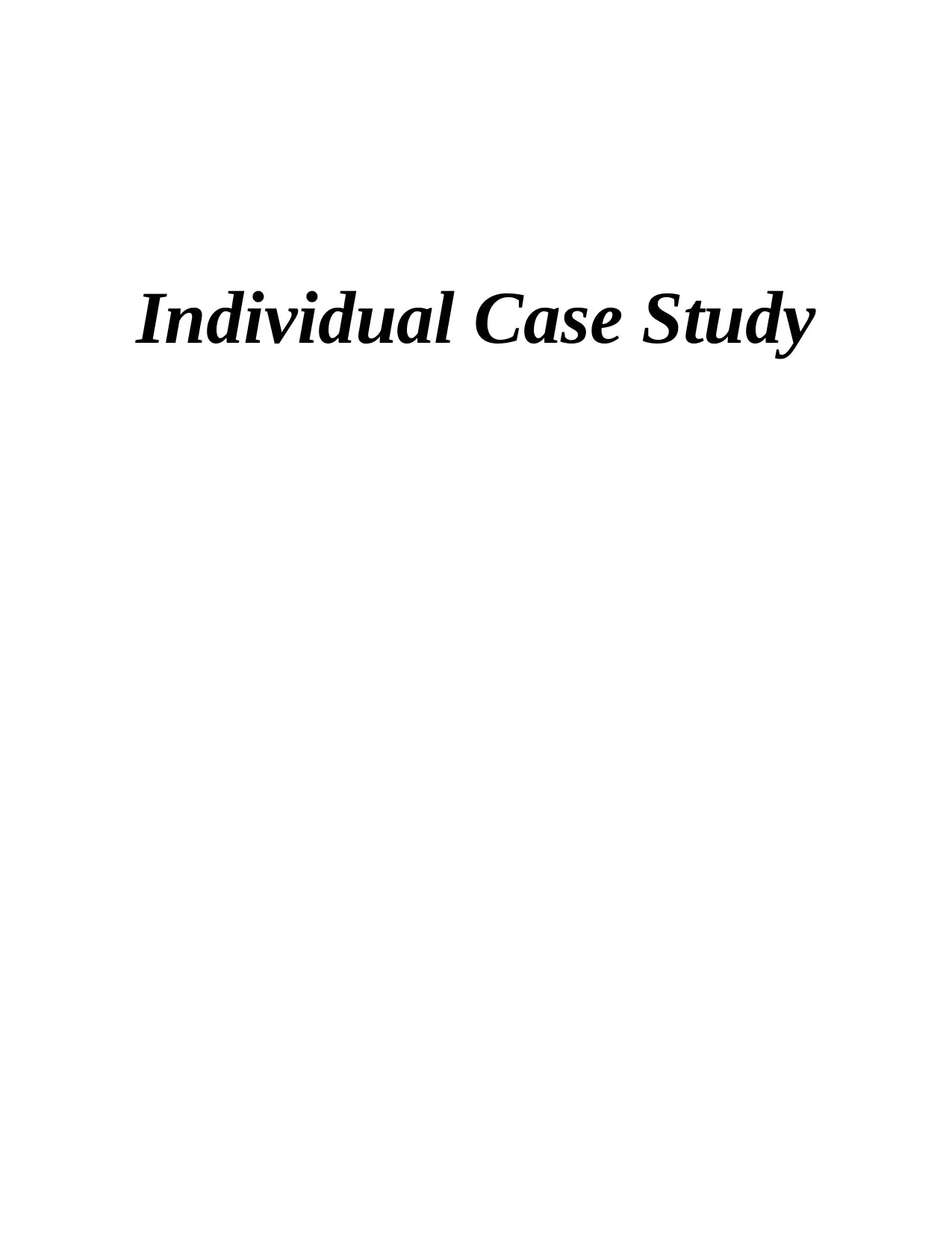
Individual Case Study
Paraphrase This Document
Need a fresh take? Get an instant paraphrase of this document with our AI Paraphraser
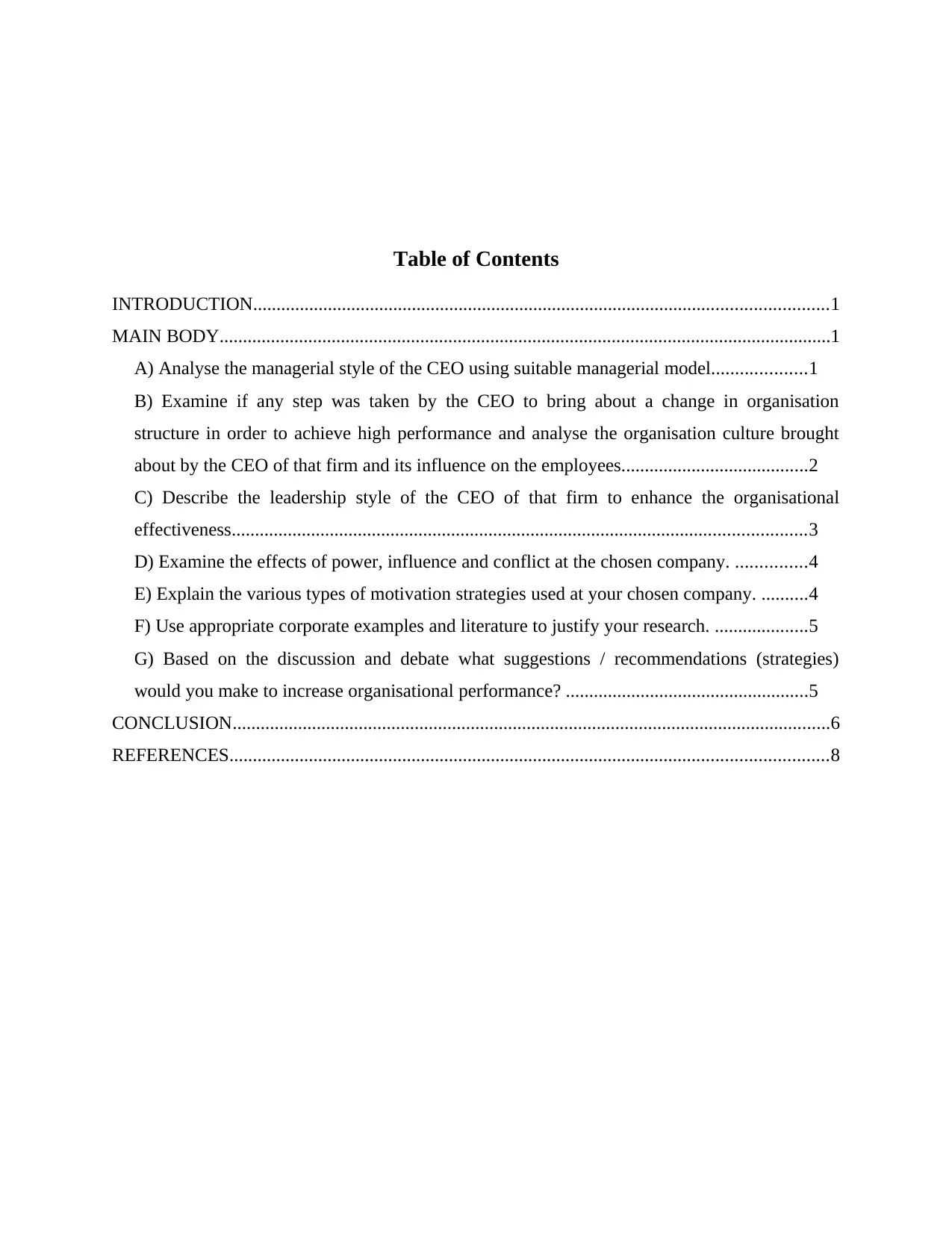
Table of Contents
INTRODUCTION...........................................................................................................................1
MAIN BODY...................................................................................................................................1
A) Analyse the managerial style of the CEO using suitable managerial model....................1
B) Examine if any step was taken by the CEO to bring about a change in organisation
structure in order to achieve high performance and analyse the organisation culture brought
about by the CEO of that firm and its influence on the employees........................................2
C) Describe the leadership style of the CEO of that firm to enhance the organisational
effectiveness...........................................................................................................................3
D) Examine the effects of power, influence and conflict at the chosen company. ...............4
E) Explain the various types of motivation strategies used at your chosen company. ..........4
F) Use appropriate corporate examples and literature to justify your research. ....................5
G) Based on the discussion and debate what suggestions / recommendations (strategies)
would you make to increase organisational performance? ....................................................5
CONCLUSION................................................................................................................................6
REFERENCES................................................................................................................................8
INTRODUCTION...........................................................................................................................1
MAIN BODY...................................................................................................................................1
A) Analyse the managerial style of the CEO using suitable managerial model....................1
B) Examine if any step was taken by the CEO to bring about a change in organisation
structure in order to achieve high performance and analyse the organisation culture brought
about by the CEO of that firm and its influence on the employees........................................2
C) Describe the leadership style of the CEO of that firm to enhance the organisational
effectiveness...........................................................................................................................3
D) Examine the effects of power, influence and conflict at the chosen company. ...............4
E) Explain the various types of motivation strategies used at your chosen company. ..........4
F) Use appropriate corporate examples and literature to justify your research. ....................5
G) Based on the discussion and debate what suggestions / recommendations (strategies)
would you make to increase organisational performance? ....................................................5
CONCLUSION................................................................................................................................6
REFERENCES................................................................................................................................8

INTRODUCTION
A manager is someone who using the different strategical approaches helps organisation
to perform better by giving direction and motivation while monitor its overall functioning. The
style adopted by a manger while doing above roles is known as managerial style which is the
result of personality, value, experience and training that the manager possess. The report will
cover the case study of Marks and Spencer which is a British multinational retailer that offer
Women-wear, Menswear and Kids-wear along with accessories and foot wear. In context to
chosen firm we analyse the managerial styles determine how CEO of firm bring change in
organisation structure of organisation. The leadership styles are discussed to enhance
organisation effectiveness and determine how power, influence and conflict impact organisation
and various motivational theories are used to motivate employees of the chosen firm. Corporate
examples are given to justify the research regarding the company's CEO and strategical
approaches and some strategies are recommended to enhance organisational performance.
MAIN BODY
A) Analyse the managerial style of the CEO using suitable managerial model
The effective CEO demonstrate fast and resolute decision making, ease to adaptability,
being reliable and engaged to stakeholders. Different CEO leadership managerial styles are
developed below:
Transformational managerial style: This style focuses on the motivation, aspiration
and empowering of employees at workplace to bring positive changes through out the
organisation (Mohammadi and Hajiheydari, 2012). Creativity is the key for its success and CEO
who follow this style are innovative in ideas and clear about values, ethics and goals of
organisation and are open to communication and opportunities. The innovation require
investment which may be heavy on the organisation budget and employees may also face
constant pressure is the downside of this style.
Authoritative Managerial style: The CEO adopting this style indulged themselves in
timely implementation of policies and strict decisions without considering the employees
perspective or help of any nature. They set performance standards and also specify rewards and
threats on missing them. It works well when there is less time to take decisions and well
established and stable hierarchy in organisation. The employees who are willing to suggestions
1
A manager is someone who using the different strategical approaches helps organisation
to perform better by giving direction and motivation while monitor its overall functioning. The
style adopted by a manger while doing above roles is known as managerial style which is the
result of personality, value, experience and training that the manager possess. The report will
cover the case study of Marks and Spencer which is a British multinational retailer that offer
Women-wear, Menswear and Kids-wear along with accessories and foot wear. In context to
chosen firm we analyse the managerial styles determine how CEO of firm bring change in
organisation structure of organisation. The leadership styles are discussed to enhance
organisation effectiveness and determine how power, influence and conflict impact organisation
and various motivational theories are used to motivate employees of the chosen firm. Corporate
examples are given to justify the research regarding the company's CEO and strategical
approaches and some strategies are recommended to enhance organisational performance.
MAIN BODY
A) Analyse the managerial style of the CEO using suitable managerial model
The effective CEO demonstrate fast and resolute decision making, ease to adaptability,
being reliable and engaged to stakeholders. Different CEO leadership managerial styles are
developed below:
Transformational managerial style: This style focuses on the motivation, aspiration
and empowering of employees at workplace to bring positive changes through out the
organisation (Mohammadi and Hajiheydari, 2012). Creativity is the key for its success and CEO
who follow this style are innovative in ideas and clear about values, ethics and goals of
organisation and are open to communication and opportunities. The innovation require
investment which may be heavy on the organisation budget and employees may also face
constant pressure is the downside of this style.
Authoritative Managerial style: The CEO adopting this style indulged themselves in
timely implementation of policies and strict decisions without considering the employees
perspective or help of any nature. They set performance standards and also specify rewards and
threats on missing them. It works well when there is less time to take decisions and well
established and stable hierarchy in organisation. The employees who are willing to suggestions
1
⊘ This is a preview!⊘
Do you want full access?
Subscribe today to unlock all pages.

Trusted by 1+ million students worldwide
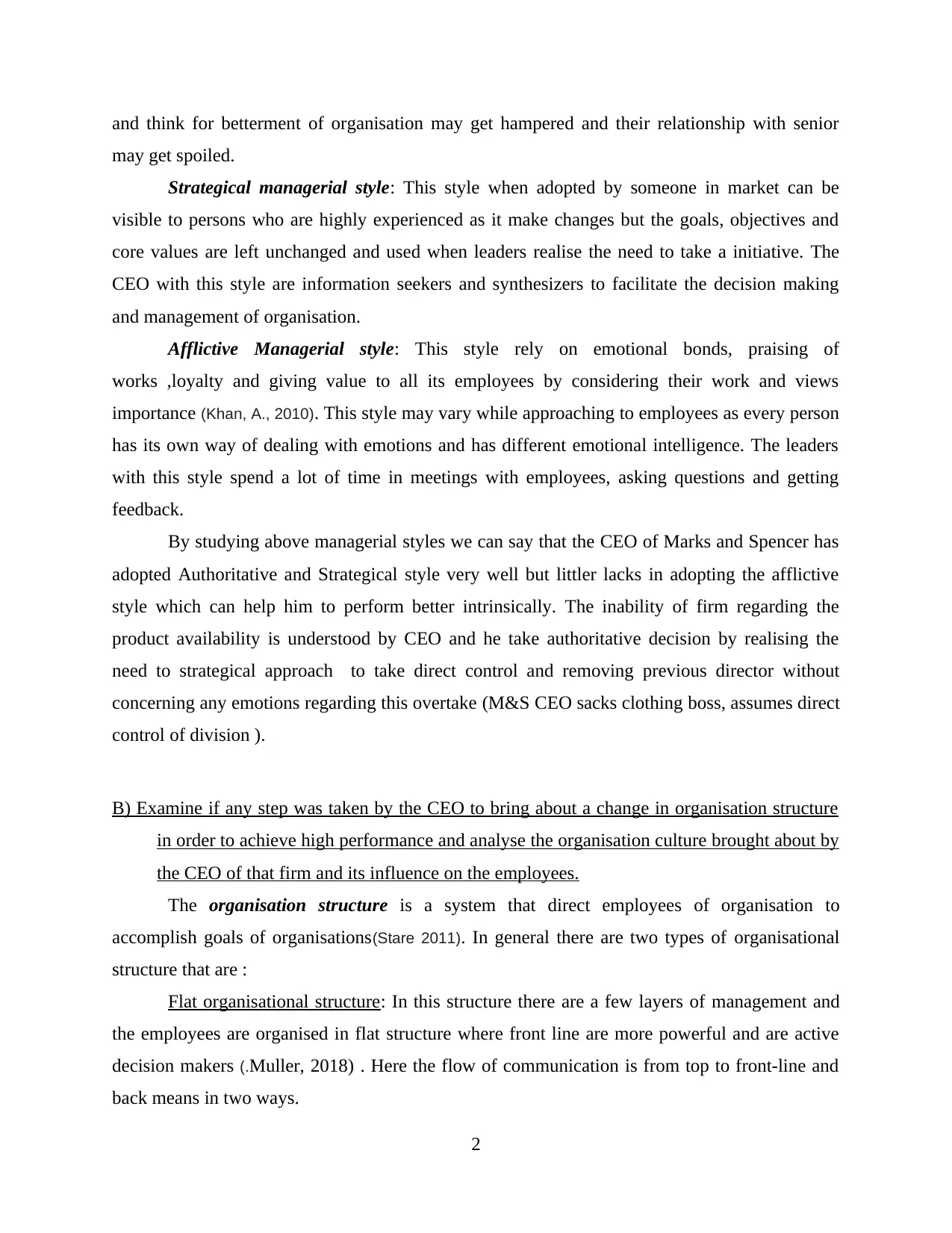
and think for betterment of organisation may get hampered and their relationship with senior
may get spoiled.
Strategical managerial style: This style when adopted by someone in market can be
visible to persons who are highly experienced as it make changes but the goals, objectives and
core values are left unchanged and used when leaders realise the need to take a initiative. The
CEO with this style are information seekers and synthesizers to facilitate the decision making
and management of organisation.
Afflictive Managerial style: This style rely on emotional bonds, praising of
works ,loyalty and giving value to all its employees by considering their work and views
importance (Khan, A., 2010). This style may vary while approaching to employees as every person
has its own way of dealing with emotions and has different emotional intelligence. The leaders
with this style spend a lot of time in meetings with employees, asking questions and getting
feedback.
By studying above managerial styles we can say that the CEO of Marks and Spencer has
adopted Authoritative and Strategical style very well but littler lacks in adopting the afflictive
style which can help him to perform better intrinsically. The inability of firm regarding the
product availability is understood by CEO and he take authoritative decision by realising the
need to strategical approach to take direct control and removing previous director without
concerning any emotions regarding this overtake (M&S CEO sacks clothing boss, assumes direct
control of division ).
B) Examine if any step was taken by the CEO to bring about a change in organisation structure
in order to achieve high performance and analyse the organisation culture brought about by
the CEO of that firm and its influence on the employees.
The organisation structure is a system that direct employees of organisation to
accomplish goals of organisations(Stare 2011). In general there are two types of organisational
structure that are :
Flat organisational structure: In this structure there are a few layers of management and
the employees are organised in flat structure where front line are more powerful and are active
decision makers (.Muller, 2018) . Here the flow of communication is from top to front-line and
back means in two ways.
2
may get spoiled.
Strategical managerial style: This style when adopted by someone in market can be
visible to persons who are highly experienced as it make changes but the goals, objectives and
core values are left unchanged and used when leaders realise the need to take a initiative. The
CEO with this style are information seekers and synthesizers to facilitate the decision making
and management of organisation.
Afflictive Managerial style: This style rely on emotional bonds, praising of
works ,loyalty and giving value to all its employees by considering their work and views
importance (Khan, A., 2010). This style may vary while approaching to employees as every person
has its own way of dealing with emotions and has different emotional intelligence. The leaders
with this style spend a lot of time in meetings with employees, asking questions and getting
feedback.
By studying above managerial styles we can say that the CEO of Marks and Spencer has
adopted Authoritative and Strategical style very well but littler lacks in adopting the afflictive
style which can help him to perform better intrinsically. The inability of firm regarding the
product availability is understood by CEO and he take authoritative decision by realising the
need to strategical approach to take direct control and removing previous director without
concerning any emotions regarding this overtake (M&S CEO sacks clothing boss, assumes direct
control of division ).
B) Examine if any step was taken by the CEO to bring about a change in organisation structure
in order to achieve high performance and analyse the organisation culture brought about by
the CEO of that firm and its influence on the employees.
The organisation structure is a system that direct employees of organisation to
accomplish goals of organisations(Stare 2011). In general there are two types of organisational
structure that are :
Flat organisational structure: In this structure there are a few layers of management and
the employees are organised in flat structure where front line are more powerful and are active
decision makers (.Muller, 2018) . Here the flow of communication is from top to front-line and
back means in two ways.
2
Paraphrase This Document
Need a fresh take? Get an instant paraphrase of this document with our AI Paraphraser
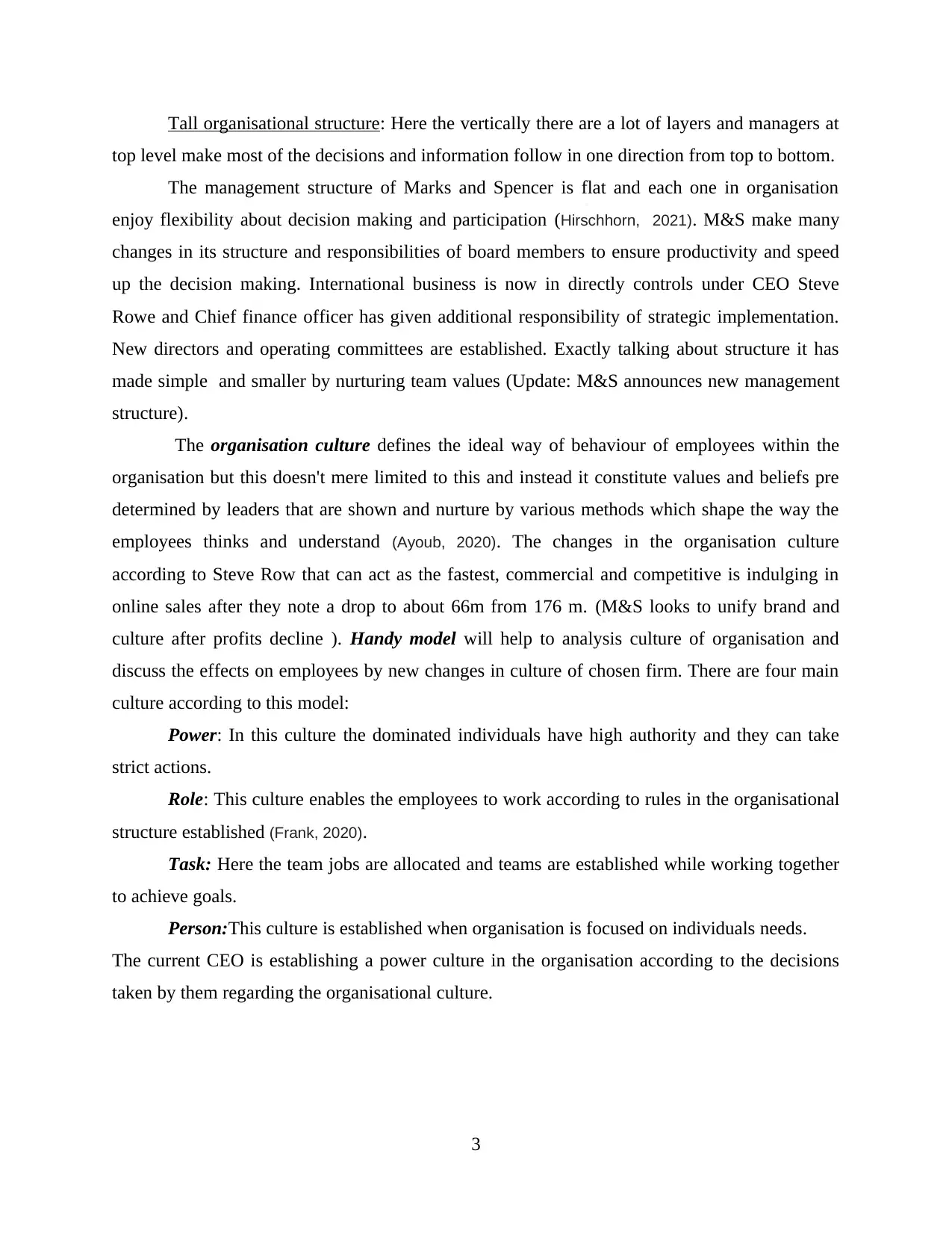
Tall organisational structure: Here the vertically there are a lot of layers and managers at
top level make most of the decisions and information follow in one direction from top to bottom.
The management structure of Marks and Spencer is flat and each one in organisation
enjoy flexibility about decision making and participation (Hirschhorn, 2021). M&S make many
changes in its structure and responsibilities of board members to ensure productivity and speed
up the decision making. International business is now in directly controls under CEO Steve
Rowe and Chief finance officer has given additional responsibility of strategic implementation.
New directors and operating committees are established. Exactly talking about structure it has
made simple and smaller by nurturing team values (Update: M&S announces new management
structure).
The organisation culture defines the ideal way of behaviour of employees within the
organisation but this doesn't mere limited to this and instead it constitute values and beliefs pre
determined by leaders that are shown and nurture by various methods which shape the way the
employees thinks and understand (Ayoub, 2020). The changes in the organisation culture
according to Steve Row that can act as the fastest, commercial and competitive is indulging in
online sales after they note a drop to about 66m from 176 m. (M&S looks to unify brand and
culture after profits decline ). Handy model will help to analysis culture of organisation and
discuss the effects on employees by new changes in culture of chosen firm. There are four main
culture according to this model:
Power: In this culture the dominated individuals have high authority and they can take
strict actions.
Role: This culture enables the employees to work according to rules in the organisational
structure established (Frank, 2020).
Task: Here the team jobs are allocated and teams are established while working together
to achieve goals.
Person:This culture is established when organisation is focused on individuals needs.
The current CEO is establishing a power culture in the organisation according to the decisions
taken by them regarding the organisational culture.
3
top level make most of the decisions and information follow in one direction from top to bottom.
The management structure of Marks and Spencer is flat and each one in organisation
enjoy flexibility about decision making and participation (Hirschhorn, 2021). M&S make many
changes in its structure and responsibilities of board members to ensure productivity and speed
up the decision making. International business is now in directly controls under CEO Steve
Rowe and Chief finance officer has given additional responsibility of strategic implementation.
New directors and operating committees are established. Exactly talking about structure it has
made simple and smaller by nurturing team values (Update: M&S announces new management
structure).
The organisation culture defines the ideal way of behaviour of employees within the
organisation but this doesn't mere limited to this and instead it constitute values and beliefs pre
determined by leaders that are shown and nurture by various methods which shape the way the
employees thinks and understand (Ayoub, 2020). The changes in the organisation culture
according to Steve Row that can act as the fastest, commercial and competitive is indulging in
online sales after they note a drop to about 66m from 176 m. (M&S looks to unify brand and
culture after profits decline ). Handy model will help to analysis culture of organisation and
discuss the effects on employees by new changes in culture of chosen firm. There are four main
culture according to this model:
Power: In this culture the dominated individuals have high authority and they can take
strict actions.
Role: This culture enables the employees to work according to rules in the organisational
structure established (Frank, 2020).
Task: Here the team jobs are allocated and teams are established while working together
to achieve goals.
Person:This culture is established when organisation is focused on individuals needs.
The current CEO is establishing a power culture in the organisation according to the decisions
taken by them regarding the organisational culture.
3
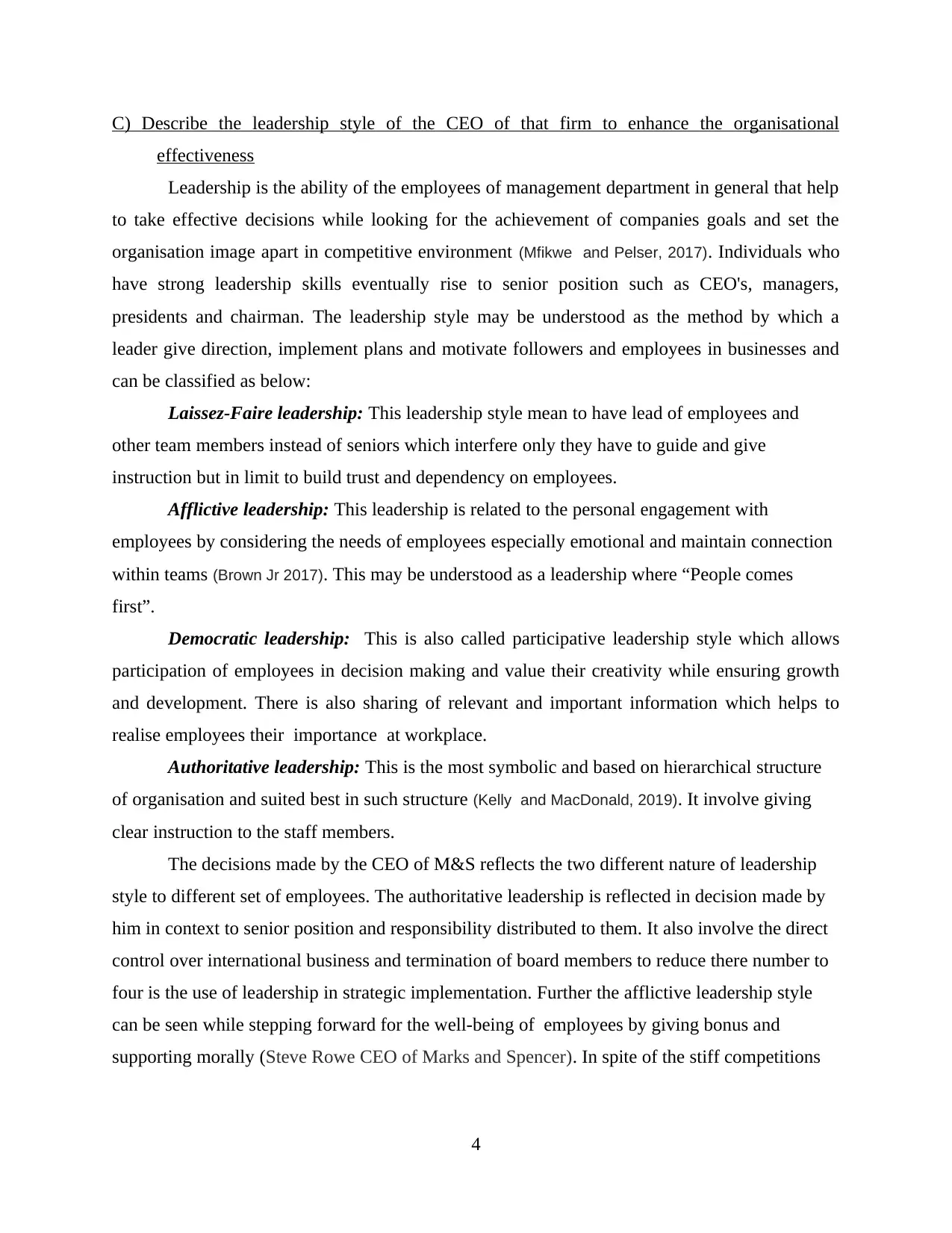
C) Describe the leadership style of the CEO of that firm to enhance the organisational
effectiveness
Leadership is the ability of the employees of management department in general that help
to take effective decisions while looking for the achievement of companies goals and set the
organisation image apart in competitive environment (Mfikwe and Pelser, 2017). Individuals who
have strong leadership skills eventually rise to senior position such as CEO's, managers,
presidents and chairman. The leadership style may be understood as the method by which a
leader give direction, implement plans and motivate followers and employees in businesses and
can be classified as below:
Laissez-Faire leadership: This leadership style mean to have lead of employees and
other team members instead of seniors which interfere only they have to guide and give
instruction but in limit to build trust and dependency on employees.
Afflictive leadership: This leadership is related to the personal engagement with
employees by considering the needs of employees especially emotional and maintain connection
within teams (Brown Jr 2017). This may be understood as a leadership where “People comes
first”.
Democratic leadership: This is also called participative leadership style which allows
participation of employees in decision making and value their creativity while ensuring growth
and development. There is also sharing of relevant and important information which helps to
realise employees their importance at workplace.
Authoritative leadership: This is the most symbolic and based on hierarchical structure
of organisation and suited best in such structure (Kelly and MacDonald, 2019). It involve giving
clear instruction to the staff members.
The decisions made by the CEO of M&S reflects the two different nature of leadership
style to different set of employees. The authoritative leadership is reflected in decision made by
him in context to senior position and responsibility distributed to them. It also involve the direct
control over international business and termination of board members to reduce there number to
four is the use of leadership in strategic implementation. Further the afflictive leadership style
can be seen while stepping forward for the well-being of employees by giving bonus and
supporting morally (Steve Rowe CEO of Marks and Spencer). In spite of the stiff competitions
4
effectiveness
Leadership is the ability of the employees of management department in general that help
to take effective decisions while looking for the achievement of companies goals and set the
organisation image apart in competitive environment (Mfikwe and Pelser, 2017). Individuals who
have strong leadership skills eventually rise to senior position such as CEO's, managers,
presidents and chairman. The leadership style may be understood as the method by which a
leader give direction, implement plans and motivate followers and employees in businesses and
can be classified as below:
Laissez-Faire leadership: This leadership style mean to have lead of employees and
other team members instead of seniors which interfere only they have to guide and give
instruction but in limit to build trust and dependency on employees.
Afflictive leadership: This leadership is related to the personal engagement with
employees by considering the needs of employees especially emotional and maintain connection
within teams (Brown Jr 2017). This may be understood as a leadership where “People comes
first”.
Democratic leadership: This is also called participative leadership style which allows
participation of employees in decision making and value their creativity while ensuring growth
and development. There is also sharing of relevant and important information which helps to
realise employees their importance at workplace.
Authoritative leadership: This is the most symbolic and based on hierarchical structure
of organisation and suited best in such structure (Kelly and MacDonald, 2019). It involve giving
clear instruction to the staff members.
The decisions made by the CEO of M&S reflects the two different nature of leadership
style to different set of employees. The authoritative leadership is reflected in decision made by
him in context to senior position and responsibility distributed to them. It also involve the direct
control over international business and termination of board members to reduce there number to
four is the use of leadership in strategic implementation. Further the afflictive leadership style
can be seen while stepping forward for the well-being of employees by giving bonus and
supporting morally (Steve Rowe CEO of Marks and Spencer). In spite of the stiff competitions
4
⊘ This is a preview!⊘
Do you want full access?
Subscribe today to unlock all pages.

Trusted by 1+ million students worldwide
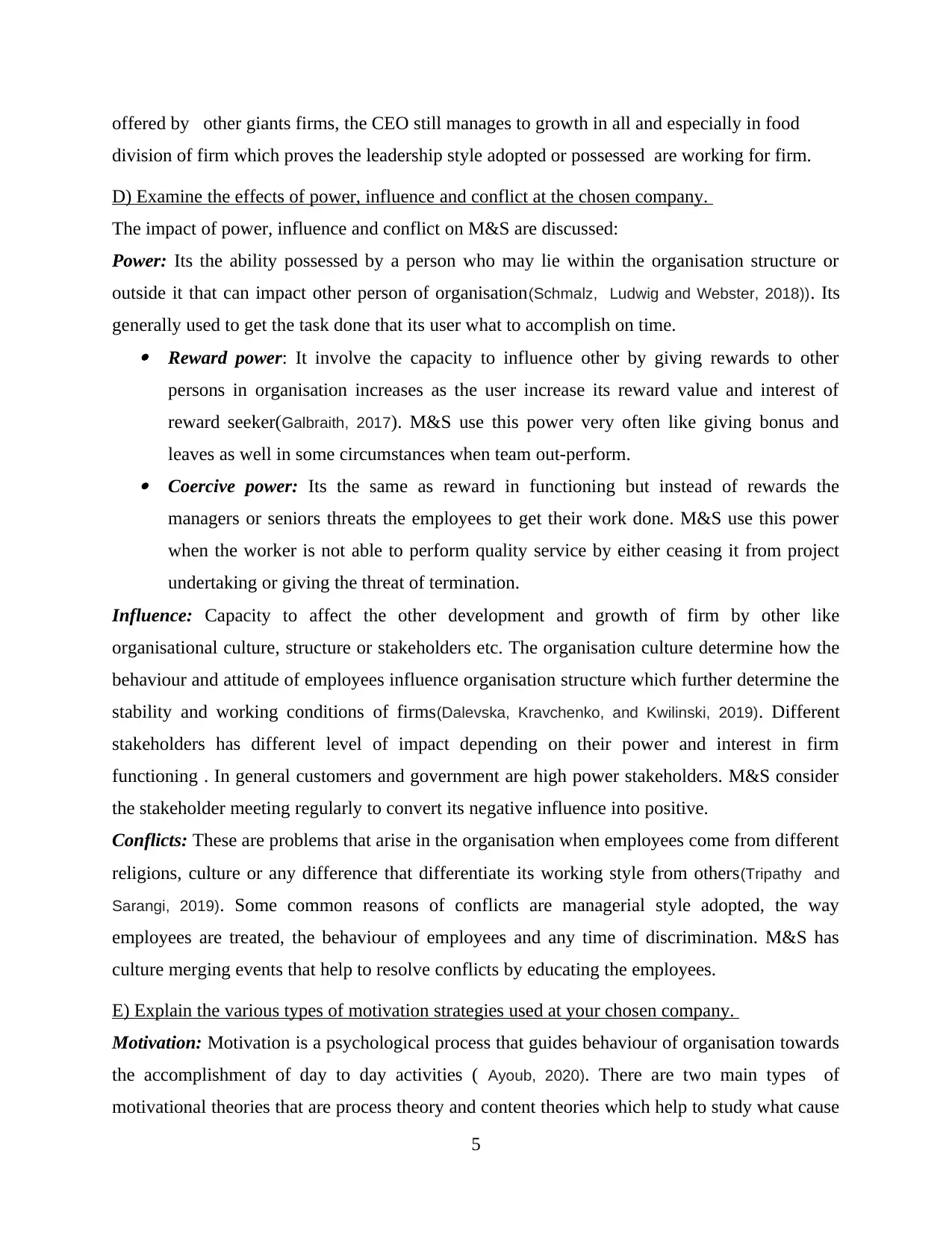
offered by other giants firms, the CEO still manages to growth in all and especially in food
division of firm which proves the leadership style adopted or possessed are working for firm.
D) Examine the effects of power, influence and conflict at the chosen company.
The impact of power, influence and conflict on M&S are discussed:
Power: Its the ability possessed by a person who may lie within the organisation structure or
outside it that can impact other person of organisation(Schmalz, Ludwig and Webster, 2018)). Its
generally used to get the task done that its user what to accomplish on time. Reward power: It involve the capacity to influence other by giving rewards to other
persons in organisation increases as the user increase its reward value and interest of
reward seeker(Galbraith, 2017). M&S use this power very often like giving bonus and
leaves as well in some circumstances when team out-perform. Coercive power: Its the same as reward in functioning but instead of rewards the
managers or seniors threats the employees to get their work done. M&S use this power
when the worker is not able to perform quality service by either ceasing it from project
undertaking or giving the threat of termination.
Influence: Capacity to affect the other development and growth of firm by other like
organisational culture, structure or stakeholders etc. The organisation culture determine how the
behaviour and attitude of employees influence organisation structure which further determine the
stability and working conditions of firms(Dalevska, Kravchenko, and Kwilinski, 2019). Different
stakeholders has different level of impact depending on their power and interest in firm
functioning . In general customers and government are high power stakeholders. M&S consider
the stakeholder meeting regularly to convert its negative influence into positive.
Conflicts: These are problems that arise in the organisation when employees come from different
religions, culture or any difference that differentiate its working style from others(Tripathy and
Sarangi, 2019). Some common reasons of conflicts are managerial style adopted, the way
employees are treated, the behaviour of employees and any time of discrimination. M&S has
culture merging events that help to resolve conflicts by educating the employees.
E) Explain the various types of motivation strategies used at your chosen company.
Motivation: Motivation is a psychological process that guides behaviour of organisation towards
the accomplishment of day to day activities ( Ayoub, 2020). There are two main types of
motivational theories that are process theory and content theories which help to study what cause
5
division of firm which proves the leadership style adopted or possessed are working for firm.
D) Examine the effects of power, influence and conflict at the chosen company.
The impact of power, influence and conflict on M&S are discussed:
Power: Its the ability possessed by a person who may lie within the organisation structure or
outside it that can impact other person of organisation(Schmalz, Ludwig and Webster, 2018)). Its
generally used to get the task done that its user what to accomplish on time. Reward power: It involve the capacity to influence other by giving rewards to other
persons in organisation increases as the user increase its reward value and interest of
reward seeker(Galbraith, 2017). M&S use this power very often like giving bonus and
leaves as well in some circumstances when team out-perform. Coercive power: Its the same as reward in functioning but instead of rewards the
managers or seniors threats the employees to get their work done. M&S use this power
when the worker is not able to perform quality service by either ceasing it from project
undertaking or giving the threat of termination.
Influence: Capacity to affect the other development and growth of firm by other like
organisational culture, structure or stakeholders etc. The organisation culture determine how the
behaviour and attitude of employees influence organisation structure which further determine the
stability and working conditions of firms(Dalevska, Kravchenko, and Kwilinski, 2019). Different
stakeholders has different level of impact depending on their power and interest in firm
functioning . In general customers and government are high power stakeholders. M&S consider
the stakeholder meeting regularly to convert its negative influence into positive.
Conflicts: These are problems that arise in the organisation when employees come from different
religions, culture or any difference that differentiate its working style from others(Tripathy and
Sarangi, 2019). Some common reasons of conflicts are managerial style adopted, the way
employees are treated, the behaviour of employees and any time of discrimination. M&S has
culture merging events that help to resolve conflicts by educating the employees.
E) Explain the various types of motivation strategies used at your chosen company.
Motivation: Motivation is a psychological process that guides behaviour of organisation towards
the accomplishment of day to day activities ( Ayoub, 2020). There are two main types of
motivational theories that are process theory and content theories which help to study what cause
5
Paraphrase This Document
Need a fresh take? Get an instant paraphrase of this document with our AI Paraphraser
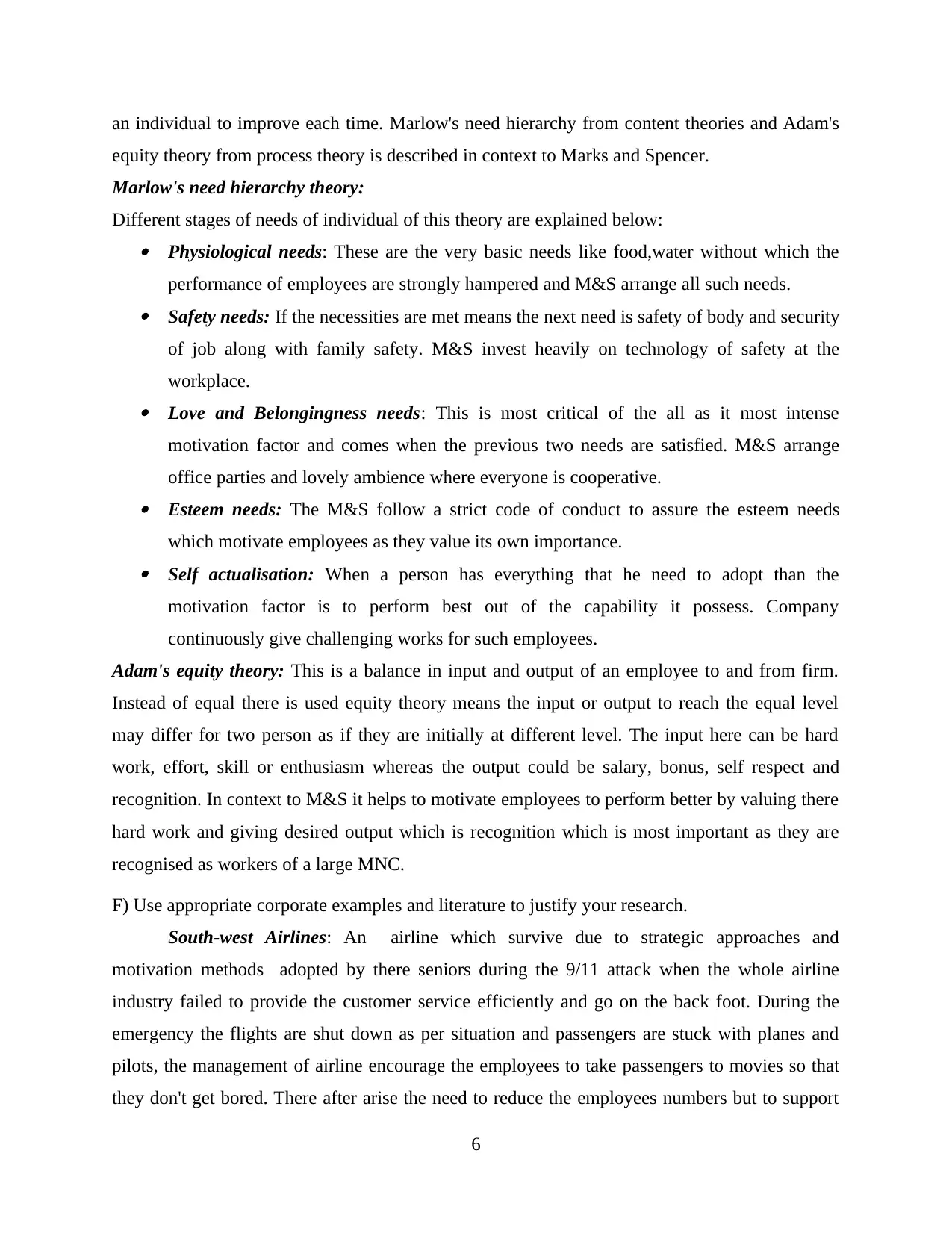
an individual to improve each time. Marlow's need hierarchy from content theories and Adam's
equity theory from process theory is described in context to Marks and Spencer.
Marlow's need hierarchy theory:
Different stages of needs of individual of this theory are explained below: Physiological needs: These are the very basic needs like food,water without which the
performance of employees are strongly hampered and M&S arrange all such needs. Safety needs: If the necessities are met means the next need is safety of body and security
of job along with family safety. M&S invest heavily on technology of safety at the
workplace. Love and Belongingness needs: This is most critical of the all as it most intense
motivation factor and comes when the previous two needs are satisfied. M&S arrange
office parties and lovely ambience where everyone is cooperative. Esteem needs: The M&S follow a strict code of conduct to assure the esteem needs
which motivate employees as they value its own importance. Self actualisation: When a person has everything that he need to adopt than the
motivation factor is to perform best out of the capability it possess. Company
continuously give challenging works for such employees.
Adam's equity theory: This is a balance in input and output of an employee to and from firm.
Instead of equal there is used equity theory means the input or output to reach the equal level
may differ for two person as if they are initially at different level. The input here can be hard
work, effort, skill or enthusiasm whereas the output could be salary, bonus, self respect and
recognition. In context to M&S it helps to motivate employees to perform better by valuing there
hard work and giving desired output which is recognition which is most important as they are
recognised as workers of a large MNC.
F) Use appropriate corporate examples and literature to justify your research.
South-west Airlines: An airline which survive due to strategic approaches and
motivation methods adopted by there seniors during the 9/11 attack when the whole airline
industry failed to provide the customer service efficiently and go on the back foot. During the
emergency the flights are shut down as per situation and passengers are stuck with planes and
pilots, the management of airline encourage the employees to take passengers to movies so that
they don't get bored. There after arise the need to reduce the employees numbers but to support
6
equity theory from process theory is described in context to Marks and Spencer.
Marlow's need hierarchy theory:
Different stages of needs of individual of this theory are explained below: Physiological needs: These are the very basic needs like food,water without which the
performance of employees are strongly hampered and M&S arrange all such needs. Safety needs: If the necessities are met means the next need is safety of body and security
of job along with family safety. M&S invest heavily on technology of safety at the
workplace. Love and Belongingness needs: This is most critical of the all as it most intense
motivation factor and comes when the previous two needs are satisfied. M&S arrange
office parties and lovely ambience where everyone is cooperative. Esteem needs: The M&S follow a strict code of conduct to assure the esteem needs
which motivate employees as they value its own importance. Self actualisation: When a person has everything that he need to adopt than the
motivation factor is to perform best out of the capability it possess. Company
continuously give challenging works for such employees.
Adam's equity theory: This is a balance in input and output of an employee to and from firm.
Instead of equal there is used equity theory means the input or output to reach the equal level
may differ for two person as if they are initially at different level. The input here can be hard
work, effort, skill or enthusiasm whereas the output could be salary, bonus, self respect and
recognition. In context to M&S it helps to motivate employees to perform better by valuing there
hard work and giving desired output which is recognition which is most important as they are
recognised as workers of a large MNC.
F) Use appropriate corporate examples and literature to justify your research.
South-west Airlines: An airline which survive due to strategic approaches and
motivation methods adopted by there seniors during the 9/11 attack when the whole airline
industry failed to provide the customer service efficiently and go on the back foot. During the
emergency the flights are shut down as per situation and passengers are stuck with planes and
pilots, the management of airline encourage the employees to take passengers to movies so that
they don't get bored. There after arise the need to reduce the employees numbers but to support
6
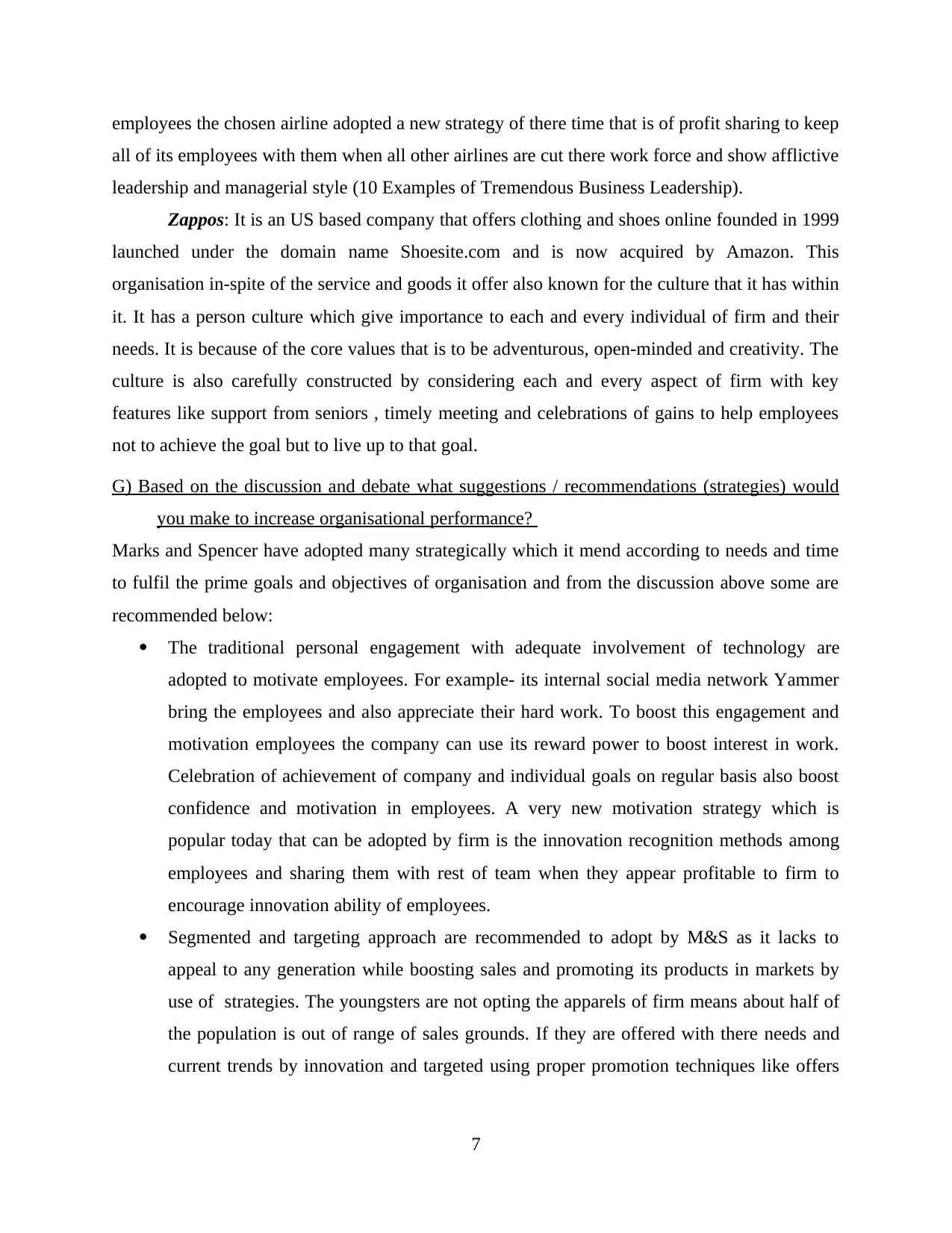
employees the chosen airline adopted a new strategy of there time that is of profit sharing to keep
all of its employees with them when all other airlines are cut there work force and show afflictive
leadership and managerial style (10 Examples of Tremendous Business Leadership).
Zappos: It is an US based company that offers clothing and shoes online founded in 1999
launched under the domain name Shoesite.com and is now acquired by Amazon. This
organisation in-spite of the service and goods it offer also known for the culture that it has within
it. It has a person culture which give importance to each and every individual of firm and their
needs. It is because of the core values that is to be adventurous, open-minded and creativity. The
culture is also carefully constructed by considering each and every aspect of firm with key
features like support from seniors , timely meeting and celebrations of gains to help employees
not to achieve the goal but to live up to that goal.
G) Based on the discussion and debate what suggestions / recommendations (strategies) would
you make to increase organisational performance?
Marks and Spencer have adopted many strategically which it mend according to needs and time
to fulfil the prime goals and objectives of organisation and from the discussion above some are
recommended below:
The traditional personal engagement with adequate involvement of technology are
adopted to motivate employees. For example- its internal social media network Yammer
bring the employees and also appreciate their hard work. To boost this engagement and
motivation employees the company can use its reward power to boost interest in work.
Celebration of achievement of company and individual goals on regular basis also boost
confidence and motivation in employees. A very new motivation strategy which is
popular today that can be adopted by firm is the innovation recognition methods among
employees and sharing them with rest of team when they appear profitable to firm to
encourage innovation ability of employees.
Segmented and targeting approach are recommended to adopt by M&S as it lacks to
appeal to any generation while boosting sales and promoting its products in markets by
use of strategies. The youngsters are not opting the apparels of firm means about half of
the population is out of range of sales grounds. If they are offered with there needs and
current trends by innovation and targeted using proper promotion techniques like offers
7
all of its employees with them when all other airlines are cut there work force and show afflictive
leadership and managerial style (10 Examples of Tremendous Business Leadership).
Zappos: It is an US based company that offers clothing and shoes online founded in 1999
launched under the domain name Shoesite.com and is now acquired by Amazon. This
organisation in-spite of the service and goods it offer also known for the culture that it has within
it. It has a person culture which give importance to each and every individual of firm and their
needs. It is because of the core values that is to be adventurous, open-minded and creativity. The
culture is also carefully constructed by considering each and every aspect of firm with key
features like support from seniors , timely meeting and celebrations of gains to help employees
not to achieve the goal but to live up to that goal.
G) Based on the discussion and debate what suggestions / recommendations (strategies) would
you make to increase organisational performance?
Marks and Spencer have adopted many strategically which it mend according to needs and time
to fulfil the prime goals and objectives of organisation and from the discussion above some are
recommended below:
The traditional personal engagement with adequate involvement of technology are
adopted to motivate employees. For example- its internal social media network Yammer
bring the employees and also appreciate their hard work. To boost this engagement and
motivation employees the company can use its reward power to boost interest in work.
Celebration of achievement of company and individual goals on regular basis also boost
confidence and motivation in employees. A very new motivation strategy which is
popular today that can be adopted by firm is the innovation recognition methods among
employees and sharing them with rest of team when they appear profitable to firm to
encourage innovation ability of employees.
Segmented and targeting approach are recommended to adopt by M&S as it lacks to
appeal to any generation while boosting sales and promoting its products in markets by
use of strategies. The youngsters are not opting the apparels of firm means about half of
the population is out of range of sales grounds. If they are offered with there needs and
current trends by innovation and targeted using proper promotion techniques like offers
7
⊘ This is a preview!⊘
Do you want full access?
Subscribe today to unlock all pages.

Trusted by 1+ million students worldwide
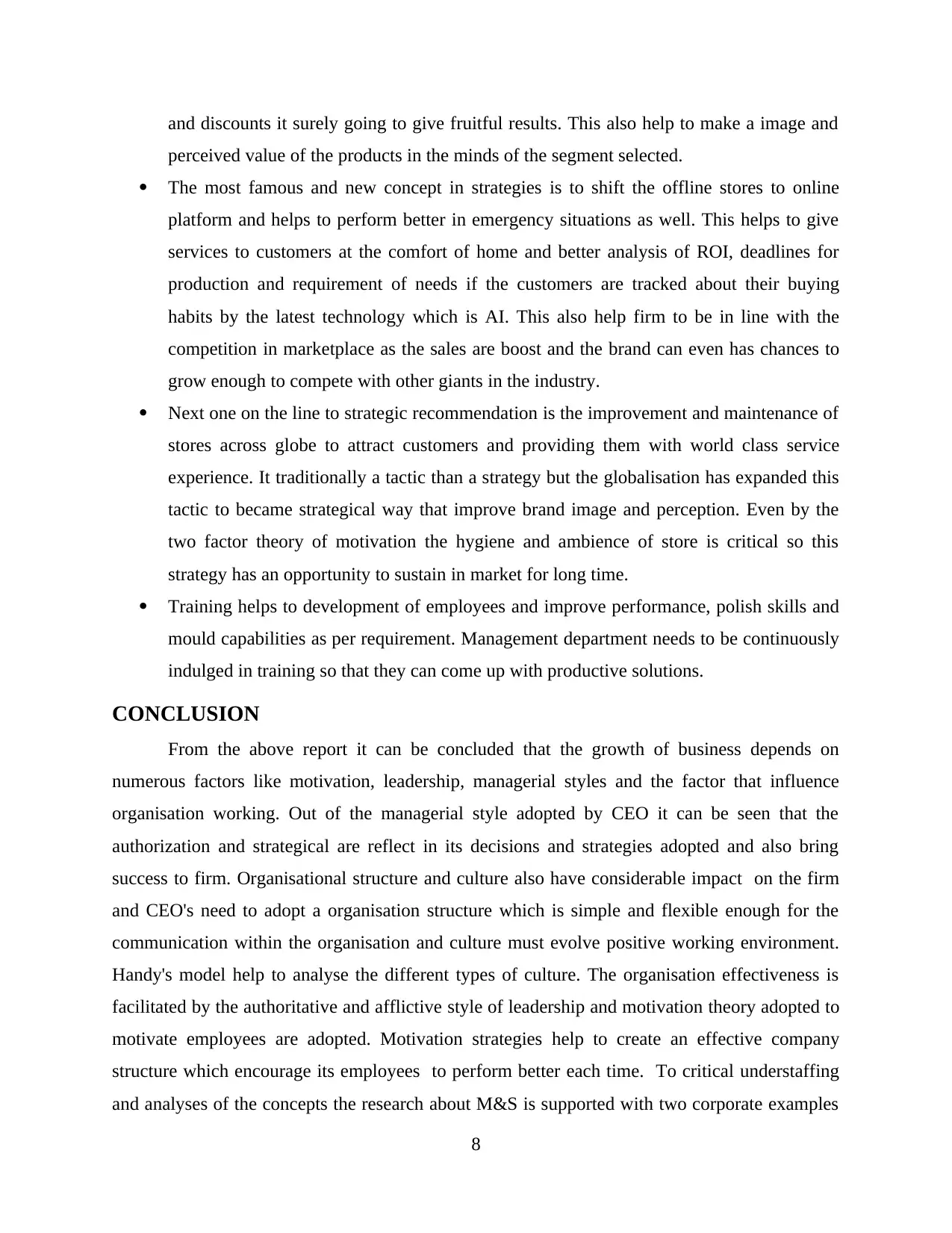
and discounts it surely going to give fruitful results. This also help to make a image and
perceived value of the products in the minds of the segment selected.
The most famous and new concept in strategies is to shift the offline stores to online
platform and helps to perform better in emergency situations as well. This helps to give
services to customers at the comfort of home and better analysis of ROI, deadlines for
production and requirement of needs if the customers are tracked about their buying
habits by the latest technology which is AI. This also help firm to be in line with the
competition in marketplace as the sales are boost and the brand can even has chances to
grow enough to compete with other giants in the industry.
Next one on the line to strategic recommendation is the improvement and maintenance of
stores across globe to attract customers and providing them with world class service
experience. It traditionally a tactic than a strategy but the globalisation has expanded this
tactic to became strategical way that improve brand image and perception. Even by the
two factor theory of motivation the hygiene and ambience of store is critical so this
strategy has an opportunity to sustain in market for long time.
Training helps to development of employees and improve performance, polish skills and
mould capabilities as per requirement. Management department needs to be continuously
indulged in training so that they can come up with productive solutions.
CONCLUSION
From the above report it can be concluded that the growth of business depends on
numerous factors like motivation, leadership, managerial styles and the factor that influence
organisation working. Out of the managerial style adopted by CEO it can be seen that the
authorization and strategical are reflect in its decisions and strategies adopted and also bring
success to firm. Organisational structure and culture also have considerable impact on the firm
and CEO's need to adopt a organisation structure which is simple and flexible enough for the
communication within the organisation and culture must evolve positive working environment.
Handy's model help to analyse the different types of culture. The organisation effectiveness is
facilitated by the authoritative and afflictive style of leadership and motivation theory adopted to
motivate employees are adopted. Motivation strategies help to create an effective company
structure which encourage its employees to perform better each time. To critical understaffing
and analyses of the concepts the research about M&S is supported with two corporate examples
8
perceived value of the products in the minds of the segment selected.
The most famous and new concept in strategies is to shift the offline stores to online
platform and helps to perform better in emergency situations as well. This helps to give
services to customers at the comfort of home and better analysis of ROI, deadlines for
production and requirement of needs if the customers are tracked about their buying
habits by the latest technology which is AI. This also help firm to be in line with the
competition in marketplace as the sales are boost and the brand can even has chances to
grow enough to compete with other giants in the industry.
Next one on the line to strategic recommendation is the improvement and maintenance of
stores across globe to attract customers and providing them with world class service
experience. It traditionally a tactic than a strategy but the globalisation has expanded this
tactic to became strategical way that improve brand image and perception. Even by the
two factor theory of motivation the hygiene and ambience of store is critical so this
strategy has an opportunity to sustain in market for long time.
Training helps to development of employees and improve performance, polish skills and
mould capabilities as per requirement. Management department needs to be continuously
indulged in training so that they can come up with productive solutions.
CONCLUSION
From the above report it can be concluded that the growth of business depends on
numerous factors like motivation, leadership, managerial styles and the factor that influence
organisation working. Out of the managerial style adopted by CEO it can be seen that the
authorization and strategical are reflect in its decisions and strategies adopted and also bring
success to firm. Organisational structure and culture also have considerable impact on the firm
and CEO's need to adopt a organisation structure which is simple and flexible enough for the
communication within the organisation and culture must evolve positive working environment.
Handy's model help to analyse the different types of culture. The organisation effectiveness is
facilitated by the authoritative and afflictive style of leadership and motivation theory adopted to
motivate employees are adopted. Motivation strategies help to create an effective company
structure which encourage its employees to perform better each time. To critical understaffing
and analyses of the concepts the research about M&S is supported with two corporate examples
8
Paraphrase This Document
Need a fresh take? Get an instant paraphrase of this document with our AI Paraphraser
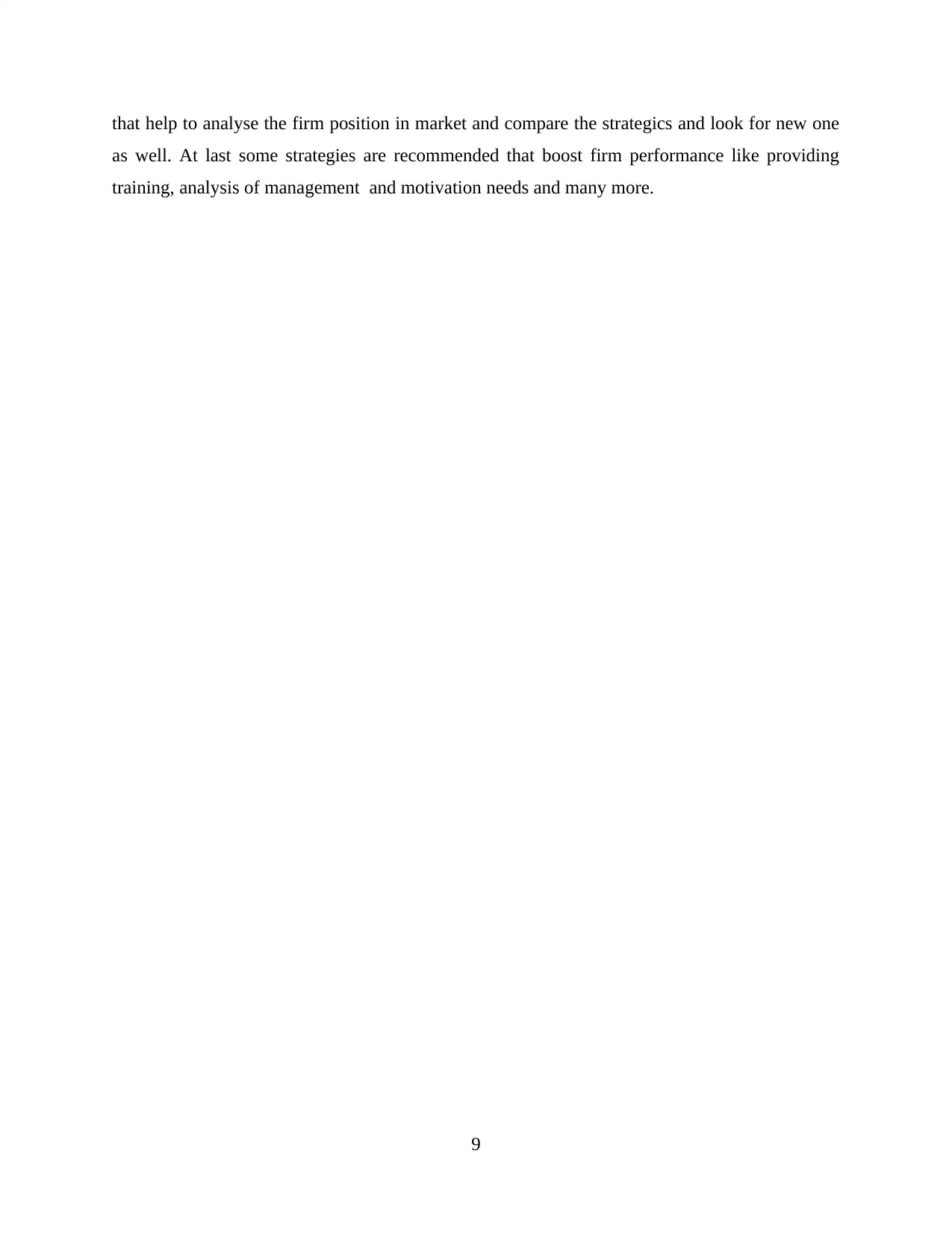
that help to analyse the firm position in market and compare the strategics and look for new one
as well. At last some strategies are recommended that boost firm performance like providing
training, analysis of management and motivation needs and many more.
9
as well. At last some strategies are recommended that boost firm performance like providing
training, analysis of management and motivation needs and many more.
9

REFERENCES
Books and Journals
Ayoub, A.R., 2020. Impact of Organisational Culture on Implementation Success of Accounting
Information Systems (AISs) in Canada and Lebanon (Doctoral dissertation, Curtin
University).
Brown Jr, W., 2017. Exploring the impact of shared leadership styles and nonprofit
performance (Doctoral dissertation, Walden University).
Dalevska, N., Kravchenko, S. and Kwilinski, A., 2019. Formation of the entrepreneurship model
of e-business in the context of the introduction of information and communication
technologies.
Frank, L., 2020. The impact of organisational culture on the involvement of indirect procurement
by their internal stakeholders: A case study from the FMCG industry (Master's thesis,
University of Twente).
Galbraith, J.K., 2017. Power and organization. In Leadership Perspectives (pp. 203-220).
Routledge.
Hirschhorn, L., 2021. Extending the Tavistock model: bringing desire, danger, dread, and
excitement into a theory of organisational process. Organisational and Social
Dynamics.21(1),.pp.114-133.
Kelly, S. and MacDonald, P., 2019. A look at leadership styles and workplace solidarity
communication. International Journal of Business Communication, 56(3), pp.432-448.
Khan, A., 2010. The Dilemma of Leadership Styles and Performance Appraisal: Counter
Strategies. Journal of Managerial Sciences. 4(1).
Mfikwe, N.M.G. and Pelser, T.G., 2017. The significance of emotional intelligence and
leadership styles of senior leaders in the South African government. Management:
Journal of Contemporary Management Issues. 22(2).pp.115-126.
Mohammadi, F. and Hajiheydari, N., 2012. How Business Intelligence Capabilities Contributed
Managerial Decision Making Styles. International Journal of e-Education, e-Business,
e-Management and e-Learning.2(1).p.28.
Muller, J.C.Y., 2018. Effective knowledge management and organisational learning in the
context of sustainable development. Electronic Journal of Knowledge
Management.6(1). pp.pp56-69.
Schmalz, S., Ludwig, C. and Webster, E., 2018. The power resources approach: Developments
and challenges. Global Labour Journal. 9(2).
Stare, A., 2011. The impact of the organisational structure and project organisational culture on
project performance in Slovenian enterprises. Management: journal of contemporary
management issues. 16(2).pp.1-22.
Tripathy, M. and Sarangi, I., 2019. Practicing the Strategies of Interpersonal Conflicts
Management in Business Organisations to Accede Development and Effectiveness in
Personal Health. Indian Journal of Public Health Research & Development. 10(1).
Online
(M&S CEO sacks clothing boss, assumes direct control of division, 2019 ) [] Available through;
<https://www.reuters.com/article/us-m-s-moves-idUKKCN1U61VH>
10
Books and Journals
Ayoub, A.R., 2020. Impact of Organisational Culture on Implementation Success of Accounting
Information Systems (AISs) in Canada and Lebanon (Doctoral dissertation, Curtin
University).
Brown Jr, W., 2017. Exploring the impact of shared leadership styles and nonprofit
performance (Doctoral dissertation, Walden University).
Dalevska, N., Kravchenko, S. and Kwilinski, A., 2019. Formation of the entrepreneurship model
of e-business in the context of the introduction of information and communication
technologies.
Frank, L., 2020. The impact of organisational culture on the involvement of indirect procurement
by their internal stakeholders: A case study from the FMCG industry (Master's thesis,
University of Twente).
Galbraith, J.K., 2017. Power and organization. In Leadership Perspectives (pp. 203-220).
Routledge.
Hirschhorn, L., 2021. Extending the Tavistock model: bringing desire, danger, dread, and
excitement into a theory of organisational process. Organisational and Social
Dynamics.21(1),.pp.114-133.
Kelly, S. and MacDonald, P., 2019. A look at leadership styles and workplace solidarity
communication. International Journal of Business Communication, 56(3), pp.432-448.
Khan, A., 2010. The Dilemma of Leadership Styles and Performance Appraisal: Counter
Strategies. Journal of Managerial Sciences. 4(1).
Mfikwe, N.M.G. and Pelser, T.G., 2017. The significance of emotional intelligence and
leadership styles of senior leaders in the South African government. Management:
Journal of Contemporary Management Issues. 22(2).pp.115-126.
Mohammadi, F. and Hajiheydari, N., 2012. How Business Intelligence Capabilities Contributed
Managerial Decision Making Styles. International Journal of e-Education, e-Business,
e-Management and e-Learning.2(1).p.28.
Muller, J.C.Y., 2018. Effective knowledge management and organisational learning in the
context of sustainable development. Electronic Journal of Knowledge
Management.6(1). pp.pp56-69.
Schmalz, S., Ludwig, C. and Webster, E., 2018. The power resources approach: Developments
and challenges. Global Labour Journal. 9(2).
Stare, A., 2011. The impact of the organisational structure and project organisational culture on
project performance in Slovenian enterprises. Management: journal of contemporary
management issues. 16(2).pp.1-22.
Tripathy, M. and Sarangi, I., 2019. Practicing the Strategies of Interpersonal Conflicts
Management in Business Organisations to Accede Development and Effectiveness in
Personal Health. Indian Journal of Public Health Research & Development. 10(1).
Online
(M&S CEO sacks clothing boss, assumes direct control of division, 2019 ) [] Available through;
<https://www.reuters.com/article/us-m-s-moves-idUKKCN1U61VH>
10
⊘ This is a preview!⊘
Do you want full access?
Subscribe today to unlock all pages.

Trusted by 1+ million students worldwide
1 out of 13
Related Documents
Your All-in-One AI-Powered Toolkit for Academic Success.
+13062052269
info@desklib.com
Available 24*7 on WhatsApp / Email
![[object Object]](/_next/static/media/star-bottom.7253800d.svg)
Unlock your academic potential
Copyright © 2020–2025 A2Z Services. All Rights Reserved. Developed and managed by ZUCOL.




